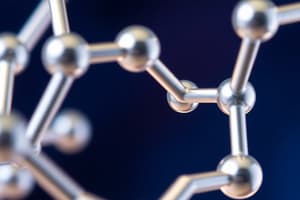Podcast
Questions and Answers
What is the primary reason for carbon's ability to form an extensive range of complex molecules?
What is the primary reason for carbon's ability to form an extensive range of complex molecules?
- Carbon's ability to form four covalent bonds. (correct)
- Carbon's ability to form only single bonds.
- Carbon's small atomic size.
- Carbon's high electronegativity.
The strength of carbon-carbon bonds plays a crucial role in:
The strength of carbon-carbon bonds plays a crucial role in:
- Lowering the melting point of organic compounds.
- Increasing the stability and complexity of organic molecules. (correct)
- Decreasing the reactivity of organic molecules.
- Reducing the boiling point of organic compounds.
Which type of hybridization leads to a linear geometry in carbon-containing compounds?
Which type of hybridization leads to a linear geometry in carbon-containing compounds?
- sp3 hybridization
- sp2 hybridization
- sp hybridization (correct)
- None of the above.
Which of the following hydrocarbons has the general formula CnH2n-2?
Which of the following hydrocarbons has the general formula CnH2n-2?
How do the boiling points of alkanes generally change as the number of carbon atoms increases?
How do the boiling points of alkanes generally change as the number of carbon atoms increases?
Which of the following best describes the difference between structural isomers and geometric isomers?
Which of the following best describes the difference between structural isomers and geometric isomers?
Which of the following is NOT a characteristic of carbon-carbon double bonds?
Which of the following is NOT a characteristic of carbon-carbon double bonds?
What is the main reason for the difference in reactivity between alkanes and alkenes?
What is the main reason for the difference in reactivity between alkanes and alkenes?
Flashcards
Tetravalency of Carbon
Tetravalency of Carbon
Carbon has four valence electrons, allowing it to form four strong covalent bonds.
Carbon Chains
Carbon Chains
Carbon can bond with itself to create chains, rings, and branched structures.
Covalent Bonds
Covalent Bonds
Carbon primarily forms strong covalent bonds with elements like hydrogen, oxygen, and nitrogen.
Hybridization
Hybridization
Signup and view all the flashcards
Hydrocarbons
Hydrocarbons
Signup and view all the flashcards
Alkanes
Alkanes
Signup and view all the flashcards
Alkenes
Alkenes
Signup and view all the flashcards
Isomerism
Isomerism
Signup and view all the flashcards
Study Notes
Chemical Nature of Carbon
- Carbon is a unique element with four valence electrons, enabling it to form strong covalent bonds with itself and other elements.
- This tetravalency allows carbon to create a vast array of complex structures.
- Carbon's ability to bond with itself results in chains, rings, and branched structures.
- These structures, in turn, form the foundation of organic molecules, including hydrocarbons and other complex biomolecules.
- Carbon's intermediate electronegativity allows it to form strong bonds with various elements, including hydrogen, oxygen, nitrogen, and sulfur.
- The strong bonds formed are largely covalent in nature.
Bonding in Carbon
- Carbon's bonding properties stem from its tetravalent nature.
- Each carbon atom can form four covalent bonds with other atoms (including other carbon atoms).
- Carbon-carbon bonds can be single, double, or triple bonds, influencing the molecule's shape and properties.
- Single bonds allow free rotation around the bond axis.
- Double and triple bonds restrict rotation around the bond axis, leading to planar or linear structures.
- The strength of carbon-carbon bonds contributes to the stability and complexity of organic molecules.
- Hybridization (sp2, sp3, sp) of the carbon atom's orbitals is pivotal in determining the geometry and bond angles in various carbon compounds.
- sp3 hybridization leads to tetrahedral geometry, sp2 to trigonal planar, and sp to linear geometry.
Bonding in Hydrocarbons
- Hydrocarbons are organic compounds composed solely of carbon and hydrogen.
- The simplest form is methane (CH4).
- Alkanes are saturated hydrocarbons containing only single bonds between carbon atoms.
- Their general formula is CnH2n+2.
- Alkenes contain at least one carbon-carbon double bond.
- Their general formula is CnH2n.
- Alkynes contain at least one carbon-carbon triple bond.
- Their general formula is CnH2n-2.
- The presence of double and triple bonds significantly affects the reactivity and properties of alkenes and alkynes compared to alkanes.
- Isomerism is a key concept in hydrocarbons.
- Structural isomers have the same molecular formula but different structural arrangements.
- Geometric isomers have different spatial arrangements of atoms around a double bond.
- The bonding arrangements in hydrocarbons strongly affect their physical properties, such as melting and boiling points, and their chemical reactivity.
- The strength and type of carbon-carbon bonds profoundly influence these properties.
- Cyclic hydrocarbons are hydrocarbons arranged in closed rings.
- They exhibit unique shapes and properties due to the ring structure.
Studying That Suits You
Use AI to generate personalized quizzes and flashcards to suit your learning preferences.




